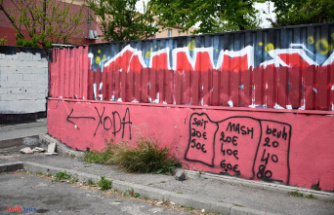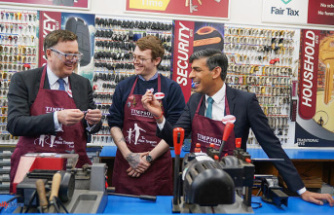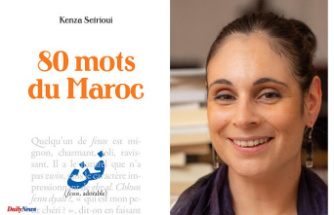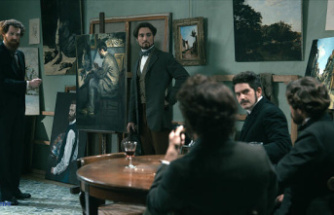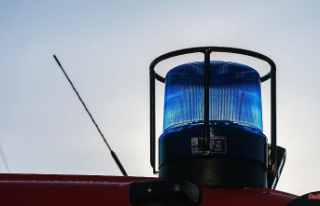Karin Kneffel creates imaginative worlds of images and renews reality in them. Her works are coveted on the market and achieve six-figure sums. Kneffel's art is currently on display in three German museums. ntv.de met the artist.
Karin Kneffel is not afraid of big names and likes to take on artist icons. In her pictures, she simply turns art by Marc Chagall upside down. She hangs works like those by Ernst Ludwig Kirchner from museums back into the living rooms where they once hung. She reinterprets Gerhard Richter's famous candle pictures. After all, he was her teacher and the fact that at 65 she is still considered one of his master students, she can only comment with a casual shrug of the shoulders.
She has long been one of the most successful women in the art system. Her virtuoso paintings sometimes cost six-figure sums, both in her Berlin gallery Friese and at Gagosian, the number one art dealer. Does that fill you with pride? "It makes me happy to go through exhibitions like this one in Kochel, to see how everything hangs and fits together. That's something that gives me lasting pleasure. Of course, it's nice that I'm being shown and sold at Gagosian . But if that were not the case, I would still paint my pictures the way I paint them." She says her success has grown slowly and steadily. She still remembers her first participation at Art Basel, the Swiss art fair where artists' careers are made. "In order to save costs, my gallery owner and I shared a room back then. We also set everything up ourselves."
That's long gone. She can currently be seen in three museums in Germany with complex works. With a view of the deep green Kochelsee in front of floor-to-ceiling windows, she spoke to n-tv in the Franz Marc Museum. She has just overseen the construction of her exhibition "Karin Kneffel. Im Blick". In the pictures on display, she cleverly layers layers of perception and time. Karin Kneffel has been working on a series of pictures since 2009, in which she depicts rooms from two Krefeld manufacturer villas and the art in them. Architect Mies van der Rohe created the two iconic buildings, Haus Lange and Haus Esters, in the late 1920s. The houses are now museums themselves.
Kneffel separates the viewer from these pictorial worlds with painted panes. They are steamed up or full of raindrops. The surroundings are reflected in them, albeit turned upside down. The view into the villa has something voyeuristic about it, seems forbidden, especially since this supposed pane creates distance in front of it. In this way, the artist mixes reality and fiction, then and now, creating surreal images. In the Franz Marc Museum, Kneffel's works of art are accompanied by the originals painted in them, such as Marc Chagall's "The Holy Cab Driver". In fact, it hangs the other way around on the museum wall than in your picture - freedom of art in a nutshell.
Karin Kneffel doesn't fit into any category. Her paintings are representational, seem hyper-realistic and yet they are not. She shrinks animals such as cows, sheep or chickens to a format the size of a serviette. Fruit, on the other hand, blows her up enormously. They grow to be a meter tall and hardly fit on the wall: their peaches, grapes or apples are pure seduction and want to be eaten immediately. "What you see is my view of the world. I don't want to depict real moments, but everything in the picture should be plausible and function as picture reality," she says firmly. Kneffel's constructs of thought are full of fantastic reflections, lavish ornaments, magical light reflections and strong quotations. Always leave room for your own interpretation. For some critics, her painting is too pleasing and banal. Collectors and museum visitors are mostly fascinated by the question: "What am I seeing there?" And that's exactly what she wants, that people think about her picture for more than just a few seconds.
Before studying art, she first studied German and philosophy in Münster. "Actually, I come from a family far from art, my father was a soccer player, my mother a cook." Kneffels was born and raised in Marl; At first she didn't realize that you could study art. In Gerhard Richter's master class in Düsseldorf, she decided to work with oil paint and brush. That was in the 1980s, and sensuous painting was pretty much out at the time.
She has nevertheless asserted herself, is now a professor at the Munich Academy of Arts and regularly visits her students. What advice does she give to those on their way? "When I said I wanted to study art, my father was very reluctant. But then, and I thought that was really great, he said that I only have one life and that I should definitely try. Life as an artist isn't It's always easy, sometimes you're very lonely with your work and you have to motivate yourself every day. I now see it like my father: you should try to fulfill your dream. If it doesn't work, there's always a way out."
Patience must be one of her strengths, because no matter which image format she chooses, a lengthy painting process follows. So how does a working day in Düsseldorf go, where she lives and works? "I'm up early, but I don't start painting until hours later. Before that I read, make phone calls, deal with emails and everything that comes up in office work in everyday life. At lunchtime I go down to the studio, which is located in our apartment building . My pictures are usually very large and often have uniform surfaces, so I sometimes have to stay with them for up to 15 hours." Why? "Otherwise you would see a seam just because I went to bed," she laughs. The large-format or small, raw canvases are primed up to seven times so that they later absorb the paint only weakly. With her very fine brushes, she can implement up to four wafer-thin layers of her ideas. Again and again she has to distance herself from what she has just painted, checking whether the proportions are right. That's why she covers several kilometers every day in the studio.
"I sketch in charcoal. A lot of people are irritated by how rough it looks and how quickly the sketches come out. I can finish it within a day. When I want to depict certain rooms, I project photos of them onto the canvas so that they are in the picture correspond to reality and are recognizable." Only then does she work her way with precision and incredible accuracy from factual backgrounds to shimmering drops of water in the foreground. Up to twenty pictures are created in this way every year. She is currently painting on a new series. "There's even a special kind of portraits that come in. I haven't done that before, I don't want anything personal," she adds. Only her small animal pictures have been a form of character painting so far. "The animals were well suited, they are strangers to me and don't raise any objections. What I'm painting now is being created for an exhibition in Rome. I can't tell you more. You'll know more in October." Until then, her mysterious world of images and ideas will fascinate curious people all over Germany.
"In the moment" until August 28, 2022 in the Max Ernst Museum, Brühl
"Karin Kneffel. In the picture" until October 3rd, 2022 to the Franz Marc Museum, Kochel am See
Karin Kneffel - presentation in the collection until October 22, 2022 Staatsgalerie Stuttgart


